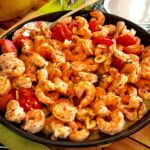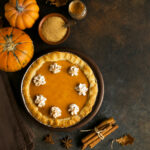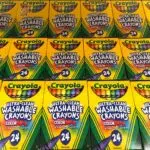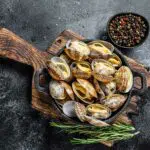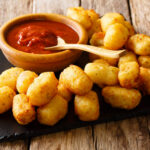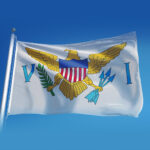On National Clams on the Half Shell Day, on March 31, seafood lovers won’t clam up about their love for clams because, today, they get to devour these meaty saltwater animals that they have probably been clamoring for for months.
As a cousin to oysters, the bivalve mollusks with their fishery goodness are best enjoyed fried, steamed, or grilled. Let’s come together to build up our appetite for clams on the half shell and eat them raw with cocktail sauce and mignonette!
History of National Clams on the Half Shell Day
Clams are formally known as bivalve mollusks; tiny, plump, and meaty sea animals that first appeared around 510 million years ago. They live in freshwater or marine habitats and are fished as one of the favorite shellfish alongside oysters and scallops.
The shellfish is cooped up in two shells, connected by a hinge joint and an internal or external ligament. There are more than 150 edible species of clams in the world and the total number of living species is somewhere around 12,000. We find most of our favorite species in the Atlantic Ocean or the Gulf Coast, including the hard-shelled quahog and mid-sized cherrystone clams, as well as the soft-shell clams that are usually steamed and the surf clams.
Some of the species in the Pacific Ocean include the littleneck, Manila, and butter clams.
Giant clam species in the South Pacific Ocean weigh 440 pounds, are inedible, and can live up to 100 years. Unfortunately, they still remain endangered. Clams have played an important role in the diet of coastal people. They live buried deep in the seabed for half of their lives and are dug out at low tide to be cooked.
While the true history of the creation of National Clams on the Half Shell Day is unknown, the famous clams casino dish with its blend of crispy breadcrumbs and topping of bacon and bell peppers dates back to 1917. It was found in the Little Casino at Narragansett, Rhode Island where the maître d’hôtel served the special dish to her guests and named it after the hotel. When diners tucked into the plump, smoked meat and bit into the stuffed topping, they were blown away. The dish was an instant success and spread across the menus of numerous restaurants in the United States.
National Clams on the Half Shell Day timeline
The oldest clam to be found in the history of marine biology (and in general), Ming, is born.
Ming the Clam is found, dug out from the seabed of Iceland, by British scientists as part of a project researching the effects of climate change.
Soon after discovering the bivalve mollusk, scientists try to pry it open — reportedly killing it in the process.
A reassessment is carried out using the carbon-14 dating method, discovering that Ming’s previously assumed age of 406 years old was incorrect and that the clam was actually 507 years old.
National Clams on the Half Shell Day FAQs
Are clams safe to eat?
As long as the shell is not cracked or half-opened, it remains safe to eat. Otherwise, toss it away because clams must be eaten alive or killed only when cooked. A cracked clamshell indicates that the clam inside is dead.
What kills clams?
Shock and temperature. So, make sure you serve them with ice when raw and be careful when shucking them.
How to know if a clam is dead or alive?
To know whether a clam is alive or has perished, gently tap the shell and force it open with your thumb on a counter. If it ‘clams up’ on instinct, it’s good and alive. If it doesn’t, it is most likely dead.
How To Celebrate National Clams on the Half Shell Day
Shuck a clam
Have you ever shucked a clam before? Well, now is the day. Watch a video tutorial to learn how to open a clam and try it at home. But make sure you do not kill it in the process.
Make a new ‘clammy’ dish
Of course, that’s a must on this day! Try a new recipe and cook the clam in a way you haven’t before. Stuffed, baked, boiled, or raw — this year, do something daring.
Let everyone know
Seafood lover or not, you’ve got to try clams on the half shell and let your social media following know about it! Post a picture of you shucking a clam, cooking it, or eating it raw.
5 Facts About Clams That Will Blow Your Mind
They don’t have brains
They have no ears, eyes, noses, or even, according to some, a brain structure — no wonder they live in shells!
They do have other body parts
If you thought this meant they’re just a blob, here’s a surprise: clams actually have a heart, kidneys, stomach, nervous system, and anus.
Ming the Clam
‘Ming was the nickname given to the oldest-living clam in history, found to be more than 500 years old.
There are giant clams
Not all clams are in tiny, edible sizes — a giant clam can grow up to four feet in size, and obviously, we can’t eat it.
When should you clam up?
The famous English saying ‘to clam up’ stems from the clam who closes its shell when touched and is an exclusively silent creature.
Why We Love National Clams on the Half Shell Day
They indicate our ocean’s health over centuries
Researchers study the ocean’s health and history using clams — the oldest living bivalve mollusk was over 500 years old and contributed to the historical findings.
Makes a divine appetizer
Restaurant-prepared clam dishes are heavenly to eat. Dipped in chowder, boiled in wine, or paired with a salad, we wouldn’t mind celebrating National Clams on the Half Shell Day every month!
It’s good for our health
Clams have a powerful nutritious profile, being a rich source of proteins, minerals, vitamins, and omega-3 fatty acids and have been found to boost sexual health.
National Clams on the Half Shell Day dates
| Year | Date | Day |
|---|---|---|
| 2026 | March 31 | Tuesday |
| 2027 | March 31 | Wednesday |
| 2028 | March 31 | Friday |
| 2029 | March 31 | Saturday |
| 2030 | March 31 | Sunday |

